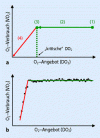[Tolerance to perioperative anemia. Mechanisms, influencing factors and limits]
- PMID: 16826416
- PMCID: PMC7095856
- DOI: 10.1007/s00101-006-1055-y
[Tolerance to perioperative anemia. Mechanisms, influencing factors and limits]
Abstract
The expected cost explosion in transfusion medicine (increasing imbalance between donors and potential recipients, treatment of transfusion-associated complications) increases the socio-economic significance of specific institutional transfusion programs. In this context the estimated use of the patient's physiologic tolerance to anemia enables 1) the tolerance of larger blood losses (loss of "diluted blood"), 2) the onset of transfusion to the time after surgical control of bleeding to be delayed and 3) the perioperative collection of autologous red blood cells. The present review article summarizes the mechanisms, influencing factors and limits of this natural tolerance to anemia and deduces the indication for perioperative red blood cell transfusion. Under strictly controlled conditions (anesthesia, normovolemia, complete muscular relaxation, hyperoxemia, mild hypothermia) extremely low hemoglobin concentrations [Hb <3 g/dl (<1.86 mmol/l)] are tolerated without transfusion by individuals with no cardiopulmonary disease. In the clinical routine these situations are limited to borderline situations e.g. unexpected massive blood losses in Jehovah's Witnesses or unexpected shortcomings in blood supply. The current recommendations coincide to the effect that perioperative red blood cell transfusion 1) is unnecessary up to a Hb concentration of 10 g/dl (6.21 mmol/l) even in older patients with cardiopulmonary comorbidity and 2) is only recommended in cases of Hb <6 g/dl (<3.72 mmol/l) in otherwise healthy subjects including pregnant women and children. Critically ill patients with multiple trauma and sepsis do not seem to benefit from transfusions up to Hb concentrations >9 g/dl (>5.59 mmol/l). In cases of massive hemorrhaging and diffuse bleeding disorders the maintenance of a Hb concentration of 10 g/dl (6.21 mmol/l) seems to contribute to stabilization of coagulation.
Die zu erwartende Kostensteigerung im Transfusionswesen (steigender Fremdblutbedarf bei gleichzeitig rückläufiger Spendebereitschaft, Behandlungspflicht transfusionsassoziierter Folgeerkrankungen) erhöht den sozioökonomischen Stellenwert der Entwicklung institutionsspezifischer Transfusionsprogramme. Ein wesentlicher Bestandteil hierbei ist – neben einer schonenden Operationstechnik und der konsequenten perioperativen Anwendung fremdblutsparender Maßnahmen – die Ausschöpfung der natürlicherweise vorhandenen „Anämietoleranz“ des menschlichen Organismus (Toleranz größerer Blutverluste durch Verlust von „verdünntem“ Blut, Hinauszögern des Transfusionsbeginns bis nach chirurgischer Blutstillung, Gewinnung von autologem Blut). In der vorliegenden Übersicht werden die Mechanismen, Einflussgrößen und Grenzen dieser natürlichen Anämietoleranz für den Gesamtorganismus und für einzelne Organsysteme zusammengefasst und die sich daraus ergebende Indikation zur Erythrozytentransfusion abgeleitet. Unter kontrollierten Bedingungen (Narkose, strikte Aufrechterhaltung von Normovolämie, komplette Muskelrelaxierung, Hyperoxämie, Hypothermie) werden von kardiopulmonal gesunden Individuen kurzzeitig auch extreme Grade der Verdünnungsanämie [Hämoglobin- (Hb-)Wert <3 g/dl (<1,86 mmol/l)] ohne Transfusion toleriert. In der klinischen Routine bleibt diese Situation – nicht zuletzt in Ermangelung eines adäquaten Monitorings – jedoch auf spezielle Sonderfälle beschränkt (z. B. unerwartete große Blutverluste bei Zeugen Jehovahs, unerwarteter Engpass bei der Bereitstellung von Fremdblut). Die derzeit geltenden Empfehlungen verschiedener Expertenkommissionen decken sich dahingehend, dass perioperativ (1) bis zu einer Hb-Konzentration von 10 g/dl (6,21 mmol/l) auch bei alten Patienten und Patienten mit kardiopulmonalen Begleiterkrankungen eine Transfusion von Erythrozyten in der Regel nicht notwendig ist und (2) eine Transfusion bei jungen, gesunden Patienten ohne kardiopulmonale Vorerkrankungen (einschließlich Schwangeren und Kindern) erst ab einer Hb-Konzentration von <6 g/dl (<3,72 mmol/l) notwendig wird. Auch beatmete Intensivpatienten mit Polytrauma und Sepsis scheinen nicht von einer Transfusion auf Hb-Konzentration >9 g/dl (>5,59 mmol/l) zu profitieren. Bei massiven Blutverlusten und diffuser Blutungsneigung scheint ein Hb von 10 g/dl (6,21 mmol/l) zur Stabilisierung der Blutgerinnung beizutragen.
Comment in
-
[Introduction to the topic: blood really is a very special fluid!].Anaesthesist. 2006 Nov;55(11):1141. doi: 10.1007/s00101-006-1090-8. Anaesthesist. 2006. PMID: 17039335 German. No abstract available.
Similar articles
-
[Perioperative management of Jehovah's Witness patients. Special consideration of religiously motivated refusal of allogeneic blood transfusion].Anaesthesist. 2010 Apr;59(4):297-311. doi: 10.1007/s00101-010-1701-2. Anaesthesist. 2010. PMID: 20379694 Review. German.
-
[Tolerance to perioperative anemia. Mechanisms, influencing factors and limits].Orthopade. 2007 Aug;36(8):763-76; quiz 777-8. doi: 10.1007/s00132-007-1126-z. Orthopade. 2007. PMID: 17701087 Review. German.
-
[Tolerance to perioperative anemia. Mechanisms, influencing factors and limits].Urologe A. 2007 May;46(5):W543-56; quiz W557-8. doi: 10.1007/s00120-007-1344-3. Urologe A. 2007. PMID: 17429601 Free PMC article. German.
-
Anemia and perioperative red blood cell transfusion: a matter of tolerance.Crit Care Med. 2006 May;34(5 Suppl):S102-8. doi: 10.1097/01.CCM.0000214317.26717.73. Crit Care Med. 2006. PMID: 16617252 Review.
-
Intraoperative Anemia and Single Red Blood Cell Transfusion During Cardiac Surgery: An Assessment of Postoperative Outcome Including Patients Refusing Blood Transfusion.J Cardiothorac Vasc Anesth. 2016 Apr;30(2):363-72. doi: 10.1053/j.jvca.2015.10.021. Epub 2015 Nov 2. J Cardiothorac Vasc Anesth. 2016. PMID: 26809765
Cited by
-
The Limits of Acute Anemia.J Clin Med. 2022 Sep 7;11(18):5279. doi: 10.3390/jcm11185279. J Clin Med. 2022. PMID: 36142930 Free PMC article. Review.
-
[Perioperative management of Jehovah's Witness patients. Special consideration of religiously motivated refusal of allogeneic blood transfusion].Anaesthesist. 2010 Apr;59(4):297-311. doi: 10.1007/s00101-010-1701-2. Anaesthesist. 2010. PMID: 20379694 Review. German.
-
Perioperative Patient Blood Management Programme. Multidisciplinary recommendations from the Patient Blood Management Initiative Group.Rom J Anaesth Intensive Care. 2017 Oct;24(2):139-157. doi: 10.21454/rjaic.7518.242.fil. Rom J Anaesth Intensive Care. 2017. PMID: 29090267 Free PMC article.
-
[Rational use of oxygen in anesthesiology and intensive care medicine].Anaesthesist. 2011 Apr;60(4):292-302. doi: 10.1007/s00101-011-1888-x. Anaesthesist. 2011. PMID: 21461755 Review. German.
-
Current Status of Measurement Accuracy for Total Hemoglobin Concentration in the Clinical Context.Biosensors (Basel). 2022 Dec 8;12(12):1147. doi: 10.3390/bios12121147. Biosensors (Basel). 2022. PMID: 36551114 Free PMC article.
References
Publication types
MeSH terms
Substances
LinkOut - more resources
Full Text Sources
Medical


